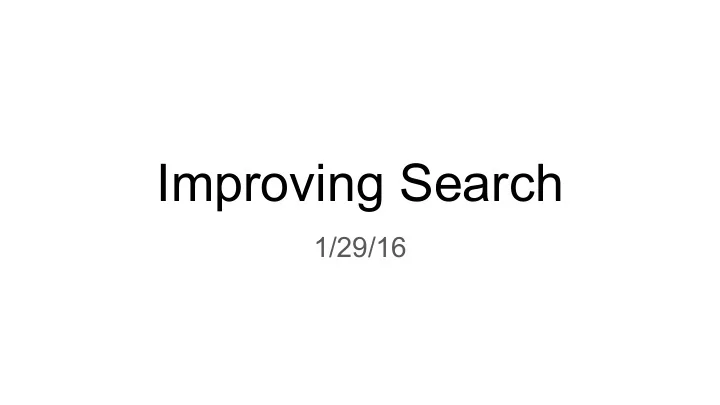

Improving Search 1/29/16
Reading Quiz Question 1: IDA* combines the advantages of A* and ________ searches. a) breadth first b) depth first c) uniform cost d) greedy
Reading Quiz Question 2: Branch and Bound combines the advantages of A* and ________ searches. a) breadth first b) depth first c) uniform cost d) greedy
Devising Heuristics (from Wednesday) ● Must be admissible : never overestimate the cost to reach the goal. ● Should strive for consistency : h(s) + c(s) non-decreasing along paths. ● The higher the estimate (subject to admissibility), the better. Key idea: simplify the problem. ● Traffic Jam: ignore some of the cars. ● Path Finding: assume straight roads.
Exercise 8 2 ... Devise a heuristic for the 8-puzzle game. 1 4 3 7 6 5 1 8 2 1 8 2 1 2 3 ... 4 3 4 3 4 5 6 7 6 5 7 6 5 7 8 1 8 2 ... 7 4 3 6 5
Why is A* complete and optimal? ● Let C* be the cost of the optimal solution path. ● A* will expand all nodes with c(s) + h(s) < C*. ● A* will expand some nodes with c(s) + h(s) = C* until finding a goal node. ● WIth an admissible heuristic, A* is optimal because it can’t miss a better path. ● Given a positive step cost and a finite branching factor, A* is also complete.
Why is A* optimally efficient? ● For any given admissible heuristic, no other optimal algorithm will expand fewer nodes. ● Any algorithm that does NOT expand all nodes with c(s) + h(s) < C* runs the risk of missing the optimal solution. ● Only possible difference could be in which nodes are expanded when c(s) + h(s) = C*.
Iterative Deepening ● Inherits the completeness and shortest-path properties from BFS. ● Requires only the memory complexity of DFS. Idea: ● Run a depth-limited DFS. ● Increase the depth limit if goal not found.
IDA*; Branch and Bound ● Use DFS, but with a bound on c(s) + h(s). ● If bound < c(goal), the search will fail and we’ll have to increase the bound. ○ IDA* starts with a low bound and gradually increases it. ● If bound > c(goal), we may find a sub-optimal solution ○ We can re-run with c(solution) - ε as the new bound ○ Branch and bound starts with a high bound and lowers it each time a solution is found. ● We can alternate these two to narrow in on the right bound. ● With reasonable bounds, these will explore an asymptotically similar number of nodes to A*, with a lower memory overhead.
Multiple simultaneous searches Bidirectional
Multiple simultaneous searches Island-Driven
Multiple simultaneous searches Hierarchy of Abstractions
Dynamic Programming ● Key idea: cache intermediate results. ● Applicable to much more than just state space search. ● The book glosses over its complexity. ○ Size of the state space graph IS NOT the right problem size. ● We’ll come back to this when we talk about MDPs (reinforcement learning).
Exercise: trace A* Use the Manhattan distance heuristic. 1 6 2 1 2 3 4 3 4 5 6 7 8 5 7 8 start goal
Recommend
More recommend